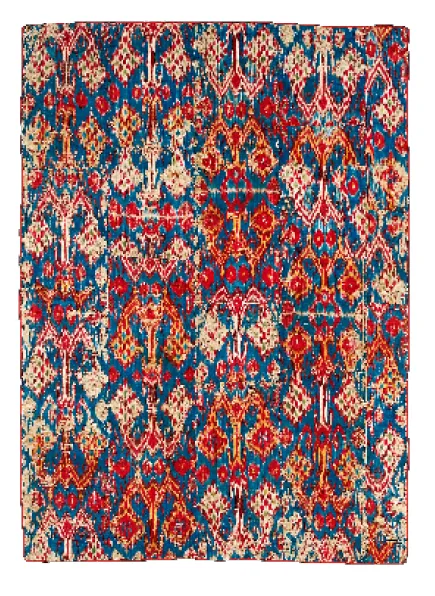
While accounts of passionate collectors of carpets were fairly common during the days of empire, no record of any westerner with the same passion for ikat has yet surfaced. Carpets and embroideries were more to the taste of early collectors; in fact, many were made for the western market. Ikat was too exotic and strange for most to embrace.
The 19th century explorer Arminius Vambery, for instance, found little to admire in local dress: “The wretched poverty among the inhabitants of Central Asia is shown in nothing more strongly than in their dress, and the eye is with difficulty accustomed to the simple cotton stuff or silk of glaring colours in which everyone is clothed, man and woman, young and old.” The typical lack of borders and deliberate asymmetry in the alignment of the panels, along with what were often described as “brash” or “garish” color combinations meant that ikat was found more often in the storage rooms of ethnological museums than on the walls of collectors of the day.
One exceptional early admirer of ikat was British explorer Robert Shaw. He travelled to Eastern Turkestan in 1868, hoping to establish a trading relationship with its ruler, Yakub Beg, who had recently seized control of the region from the Chinese. Shaw seems to have treasured his ikat robes, presented to him as gifts during his time in Yarkand and Kashgar. Back home in India, they were used by his family as props in domestic playacting, images of which are preserved in a family album. Though clearly fond of their textiles, they owned them only briefly before donating them to English museums in the 1870s.
It would be not be until the 1970s that Europeans and Americans developed a real appreciation for the material. The 1972 publication of Alfred Janata’s seminal three volume work on resist dyed textiles in German was followed by a major English language collaboration with the designer Jack Lenor Larsen that for many readers was their first introduction to the vast world of ikat. Buhler’s wish, that “the study of resists go beyond museum circles, to the people, and especially to textile artists” found fulfillment in the efforts of collectors like Dr. David Paly, a medical doctor and amateur of the Central Asian textile tradition.
You can learn more about the topic in the book-album "The Cultural legacy of Uzbekistan in private collections of the USA and Canada" (volume XXXI) in the series "Cultural Legacy of Uzbekistan in the World Collections".
The main sponsor of the project is the oilfield services company Eriell-Group.
